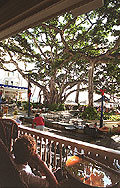By Heidi Bornhorst
There is an exceptional Indian banyan tree in the beachside courtyard of the Sheraton Moana Surfrider hotel that sure could tell some stories, if it could talk. The Moana is about to celebrate its centennial and the tree is even older than the hotel.
 |
| The Sheraton Moana Surfrider’s famous Indian banyan tree has been selected as Hawai‘i’s Millennium Landmark Tree.
Deborah Booker • The Honolulu Advertiser |
This tree has been selected by the trustees of the America the Beautiful Fund as the Hawai‘i Millennium Landmark Tree.
"The Millennium Landmark Tree recognition is being given to honor one tree in each state that holds important national and local historic value, with the pledge that it will be protected and preserved for the enjoyment of future generations," said Nanine Bilski, president of the fund.
This tree is recognized (and protected) by Honolulu city ordinance as exceptional for several reasons: It is old, historic and magnificent. Generations have sheltered under its shade. The famous radio show "Hawai‘i Calls" was recorded under its branches from 1935 to 1975.
Many of us have eaten a meal, enjoyed a highball or attended a civilized lady surfers tea under the wide-spreading shady branches of this tree that graces the oldest hotel in Waikiki.
Speaking of surfers, this tree offers a view of the ocean and the famed rolling surf of Waikiki. Just think how many sets of waves, swells and high and low tides the tree has "seen" and its roots have "felt." (The tides and surf affect the groundwater levels in Waikiki and the root systems of all trees there, especially one planted so close to the ocean).
Indian banyans or Ficus benghalensis have large leaves, red fruit and many long aerial roots that drop from the main trunk and into the ground, forming more trunks. The large leaves, and very tropical and wild-looking aerial roots, are some of the most distinct features of this type of ficus.
Another obvious feature is that these are not small trees. They can become huge and are suitable for large majestic spaces such as the Moana, ‘Iolani Palace, the Honolulu Zoo and Kapi‘olani Park. One of the most famous and large Indian banyans in Hawai‘i is found in Lahaina, Maui. This one is the dominant feature of a whole shoreline park.
Indian banyans are native to tropical Asia. Here in Hawai‘i, they grow to about 100 feet tall, often spreading even wider if aerial roots are allowed to develop into more trunks. One of the largest in the world grows at the Calcutta botanical garden in India. It has so many trunks it’s said that it takes 10 minutes to walk around it!
Poet and author Robert Louis Stevenson spent quite a bit of time in Hawai‘i and loved it here. He wrote a poem for Princess Ka‘iulani while sitting under the shade of a Waikiki banyan. He missed the lovely young hapa princess, who was away from her beloved islands, visiting in Europe.
He composed the following poignant poem:
Her islands here in Southern sun,
Shall mourn their Ka‘iulani gone,
And I, in her dear banyan shade,
Look vainly for my little maid.
Banyans got their common name from the Banians, Hindu traders who gathered and camped in the cool deep shade of these trees. The banyan is sacred to Hindus, as it is believed that Brahma was transformed into a banyan tree.
Banyans are in the Moraceae plant family and are related to breadfruit, or ulu, and paper mulberry, or wauke, and edible figs (banyan fruit look like mini figs and are relished by birds but not too ono for us).
If you collect a banyan tree fruit in India, you can grow a new plant. Here in Hawai‘i, nothing will happen as the precipe wasp that can pollinate Indian banyans does not live here.
The pollinating wasp for Chinese banyans was intentionally brought into the islands to help with reforestation and now Chinese banyan is a pest that pops up everywhere.
To grow an Indian banyan, you would have to get a seed from its original home, or make an air layer or division from a tree here. Just make sure you have a VERY big garden!!
[back to top] |

 The Great Index to Fun
The Great Index to Fun